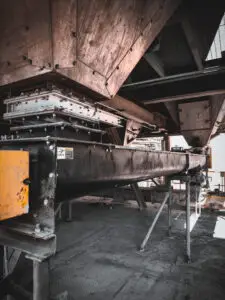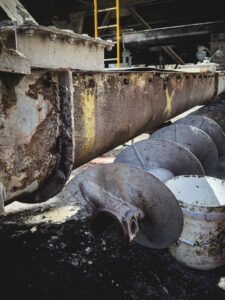This article provides an in-depth understanding of screw conveyors, including their components, applications across industries, and the materials they typically transport. Recognized for their versatile design and compact structure, screw conveyors serve as a widely used method for conveying materials in various industrial sectors.
Screw Conveyor Basics
Components of a Screw Conveyor
Configurations of Screw Conveyors
Key Considerations for Screw Conveyor Use
Leading Manufacturers of Screw Conveyors
Summary

Screw conveyors are extensively utilized to transport bulk solids, granular solids, liquids, slurries, and non-flowing materials in industrial environments. Their basic structure consists of a rotating screw (auger) within a trough, which propels material toward the discharge end as it turns. These conveyors can operate at various inclinations, ranging from horizontal to vertical orientations.
Dating back to 250 BCE, screw conveyors were initially invented by Archimedes to lift water for irrigation. Today, these conveyors, sometimes referred to as auger conveyors, remain integral to bulk material handling operations. Their adaptability makes them suitable for diverse applications, including those handling abrasive, toxic, or non-free-flowing materials.
Although manufacturers may alter designs, most screw conveyors consist of fundamental components that contribute to their functionality. Not every screw conveyor incorporates all listed components, but the most common ones are described below.
The core component of a screw conveyor is the screw (auger), which facilitates material movement. It consists of a central shaft with a spirally wound blade called the flight. Various flight designs cater to different materials and applications:
Standard Pitch: Commonly used in horizontal conveyors, featuring a pitch equal to the screw diameter.
Variable Pitch: Designed for controlled volumetric flow, with a gradually increasing pitch.
Short Pitch: Used in vertical and steeply inclined conveyors to minimize agitation of free-flowing materials.
Half Pitch: Ideal for inclined conveyors, providing greater material control.
Long Pitch: Utilized for transporting liquids at a higher speed.
Double Flight: Two flights ensure uniform flow rates and faster material transport.
Tapered Flight: Flight width increases from intake to discharge, enabling even material distribution.
Mass Flow: Conical flights with variable pitch promote consistent flow.
Helicoid Flight: Constructed for durability, handling moderately abrasive materials.
Sectional Flight: Designed for highly abrasive materials, offering superior strength.
Cut Flight & Cut and Folded Flight: Facilitate material agitation and aeration, preventing clumping.
Ribbon Flight: Features gaps between the shaft and flight, ideal for viscous or sticky materials.
Standard Pitch with Paddles: Primarily used for mixing applications rather than transport efficiency.
Screw conveyors can be right-handed or left-handed, determining material flow direction based on rotation. In specialized applications, bi-directional screws enable discharge at multiple points.

The trough houses and guides the material being conveyed. Its design variations include:
U-Shaped: The most common and cost-effective option, adaptable to various materials.
Rectangular: Used for abrasive materials, creating a protective layer to prevent trough wear.
Tubular: Ideal for high-speed operations, commonly found in inclined and vertical conveyors.
Jacketed: Incorporates heating or cooling capabilities for temperature-sensitive materials.
Hanger Bearings: Support long shafts and allow rotational movement while reducing deflection.
Couplings: Connect sections of the screw, ensuring alignment and facilitating long-distance transport.
Internal Collars & End Lugs: Reinforce screw stability and torque handling.
Drive System: Typically mounted at the discharge end, consisting of electric, hydraulic, or pneumatic motors with gear mechanisms.
Screw conveyors can be categorized based on their flow path, each suited for specific applications.
The simplest and most widely used type.
Supports multiple inlets and outlets.
Typically loaded at 15-45% capacity, depending on material characteristics.
Operates at angles up to 45 degrees.
Requires higher power input and specialized screw designs (e.g., short pitch screws).
Used for steep inclinations (45-90 degrees).
Typically housed in a sealed, round trough for efficient transport.
Shaftless Screw Conveyors: Ideal for viscous or sticky materials.
Live Bottom Screw Conveyors: Used beneath silos, bins, and hoppers for controlled material discharge.
Flexible Screw Conveyors: Feature tubular, flexible troughs, allowing transport through complex layouts.
When selecting or designing a screw conveyor, key factors include:
Layout Constraints: The number of intakes/outlets, distance, and obstacles affect design.
Material Properties: Free-flowing, viscous, sticky, and abrasive materials require specific configurations.
Structural Requirements: Particle size, density, and volumetric feed rate influence screw sizing and strength.
While The ACT Group specializes in custom screw conveyors, other leading manufacturers include:
Spiroflow Systems, Inc.
Conveyor Engineering and Manufacturing
Screw conveyors remain an essential component in bulk material handling, offering flexibility across industries. With varied configurations and specialized designs, these conveyors efficiently handle a diverse range of materials. Their reliability, coupled with customization options, ensures suitability for even the most challenging applications.
For expert consultation and custom screw conveyor solutions, contact The ACT Group today!
Monthly Industry Information Plus Special Deals on Parts & Services!!